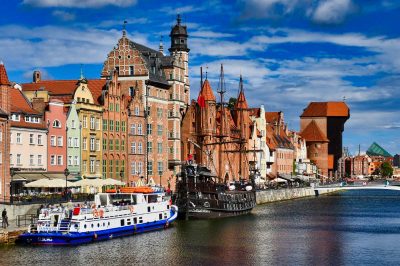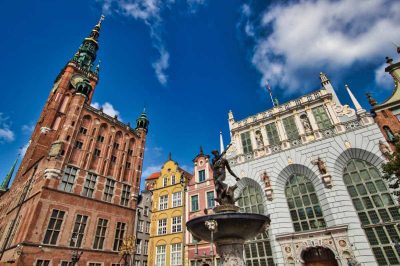Szczecin has a rich history as one of the most important cities of old Pomerania. Szczecin impresses visitors with its wide parks, great Wilhelminian architecture, a beautiful harbor promenade with one of the best terraces in Europe, interesting museums, cool pubs and delicious food. Szczecin offers you a wonderful short trip to get to know the culture of Poland. Here you will learn all about the city’s eventful past, get to know Szczecin’s most beautiful sights and find out what you absolutely must see and try.
This is Szczecin
Szczecin is the most north-western major city in Poland and lies at the mouth of the River Oder into the Szczecin Lagoon. It is just 10 km from the city center to the border with Mecklenburg-Vorpommern. The city experienced a real boom after the Second World War and now has 400,000 inhabitants, making it the seventh largest city in the country (behind Gdansk and ahead of Bydgoszcz). The city is best known for its spectacular Philharmonic Hall, the Castle of the Pomeranian Dukes and the Hakenterrasse. Economically, the port is of particular importance, and there are three universities in Szczecin. Incidentally, the inhabitants of the city are jokingly referred to as paprykarzy after a dish made from herring, rice, tomatoes and onions, which is often canned.

History of Szczecin
Szczecin’s roots go back to the early Middle Ages, when Slavic tribes settled here. In the 13th century, several local communities were united under the Pomeranian Duke Barnim I and were granted town charter, and the actual town was born. Due to its favorable location at the northern end of the Oder, Szczecin quickly developed into an important trading center and joined the Hanseatic League as early as 1278. Otto I of the House of the Griffins, the Pomeranian dukes, made the town his residence in 1309.
Szczecin was under Swedish rule for 80 years
In the 16th century, the Reformation was introduced in Szczecin, as in the whole of Pomerania. At that time, the existing castle was also rebuilt into a Renaissance-style complex, which has been restored to its former glory after being destroyed in the Second World War. In 1630, the town was taken by Swedish troops. It remained under Swedish control for over 80 years before falling to Prussia under Frederick William I. Under the ruler known as the Soldier King, Szczecin was then developed into a modern fortress city, which can still be seen in parts of the cityscape today.
In 1815, Szczecin experienced a significant upgrade, as it was declared the capital of the province of Pomerania within Prussia and thus the administrative seat of an area that reached as far west as just before Rostock and as far east as just before Gdansk, as well as encompassing large parts of the Baltic hinterland. The following decades were characterized by industrialization, with the port in particular playing an increasingly important role. Due to its location close to the Baltic Sea, the city was an easy target for air raids during the Second World War and over 90 percent of the old town was destroyed.
After the Second World War, it was initially unclear what would happen to Szczecin, as the city area extended on both sides of the Oder, which, as is well known, was to form the border between the newly founded GDR and the People’s Republic of Poland. The city west of the Oder was therefore initially administered by German communists after the war, before it was handed over to Poland and the German population was expelled.
The years 1970 and 1980 showed how critical the newly settled Polish residents were of the communist rulers, when there were riots and strikes, which were very important for the emergence of Solidarność and thus for the later downfall of communism in Poland. Szczecin has been the capital of the West Pomeranian Voivodeship since 1999. Despite the general decline in shipyards, the city’s economic prospects look very good and its proximity to the Baltic Sea and the German border make Szczecin attractive to investors.
These are the most beautiful sights in Szczecin
Szczecin can therefore look back on a rather eventful German-Polish past. And this can still be felt today in many places in the city center and on the outskirts of the city. So it’s high time to introduce you to the most beautiful sights in Szczecin!
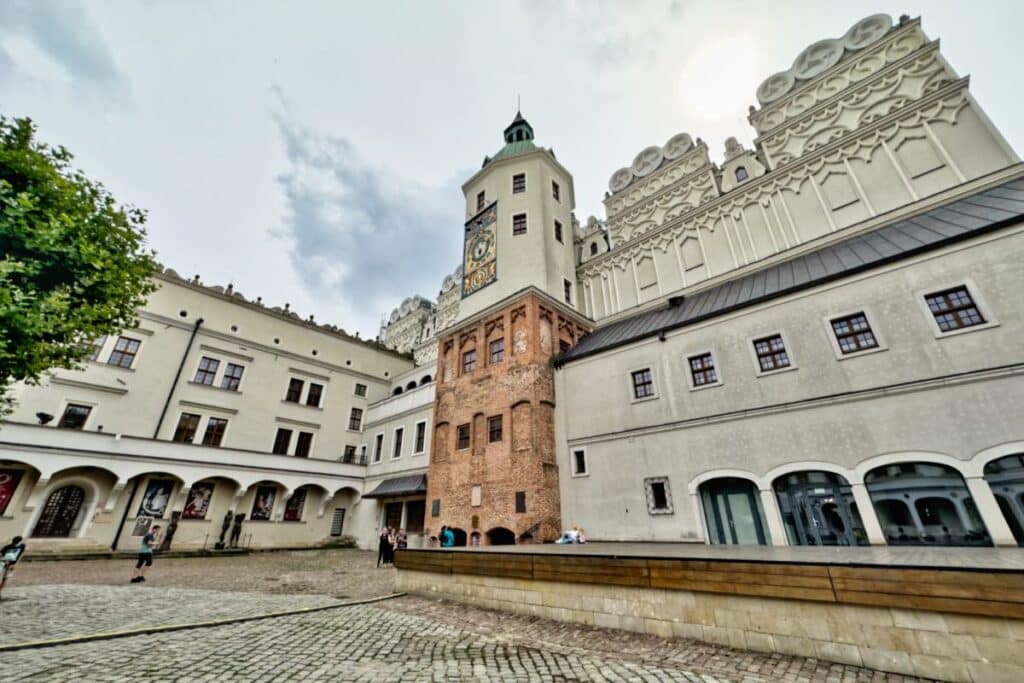
Castle of the Pomeranian Dukes
When people think of Szczecin in Poland, the first thing that comes to mind is the Castle of the Pomeranian Dukes, also known as the Griffin Castle. No wonder, as it is one of the most magnificent Renaissance castles in the country! The castle is not the first such complex in the city, as the representative seat of the Griffin dukes stood here as early as the 14th century. Due to disputes with local residents, the construction of the castle took a long time, but it was given its present form under the Italian Renaissance specialist Antonio Wilhelmi. In Prussian times, the later King Friedrich Wilhelm IV lived here for a time.
Today, the castle, which was extensively rebuilt after the Second World War, is home to various institutions, such as a registry office and a theater. It is also home to the excellent Na Kuncu Korytarza restaurant (see restaurant tips). You can easily visit the inner courtyard. Be sure to take a look at the curious tower clock from the 17th century. Here you can see a bizarre mask that turns its eyes in the direction of the hand and displays the exact date. You should also not miss a climb up the bell tower, from where you have a great view of the city! All this makes the Griffin Castle the most historically significant of all Szczecin’s sights.

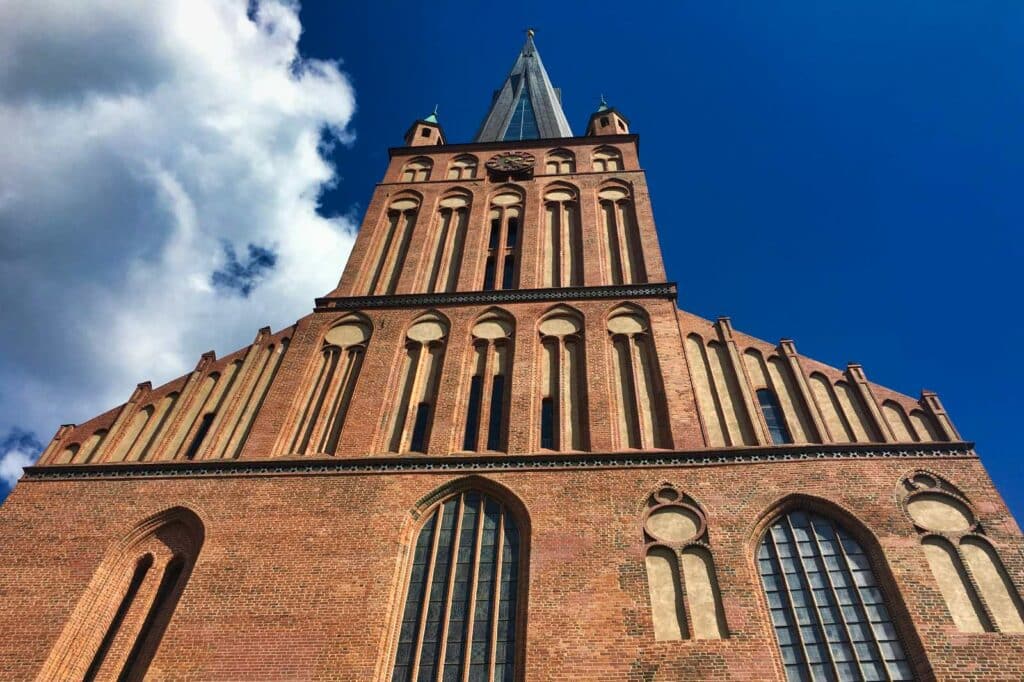
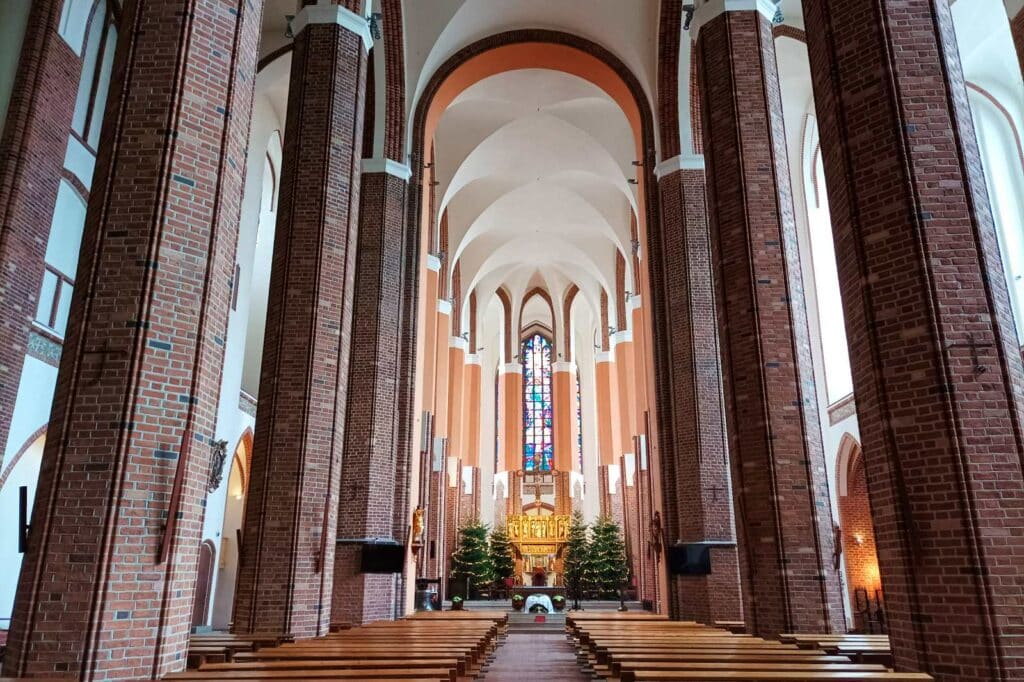

Cathedral
Via ulica Grodzka you can get from the castle directly to St. James’ Cathedral. It is dedicated to St. James and is the most important place of worship in the city. Together with Cammin Cathedral in Kamień Pomorski, the church is the seat of the Archbishop of Szczecin-Cammin and was built in the Gothic style from the 13th century onwards. Due to the Reformation, only a few of the church’s former 52(!) altars have been preserved, but these are well worth seeing.
The building with its unusually long choir has a great lighting atmosphere and appears bright and open. An interesting detail for music fans: the first performance of Felix Mendelssohn Bartholdy’s Midsummer Night’s Dream took place here in 1735. Two elevators take you comfortably up to a viewing platform from where you have a great view of the city! However, the view is less suitable for photos, as everything is glazed and the windows are unfortunately not always clean.
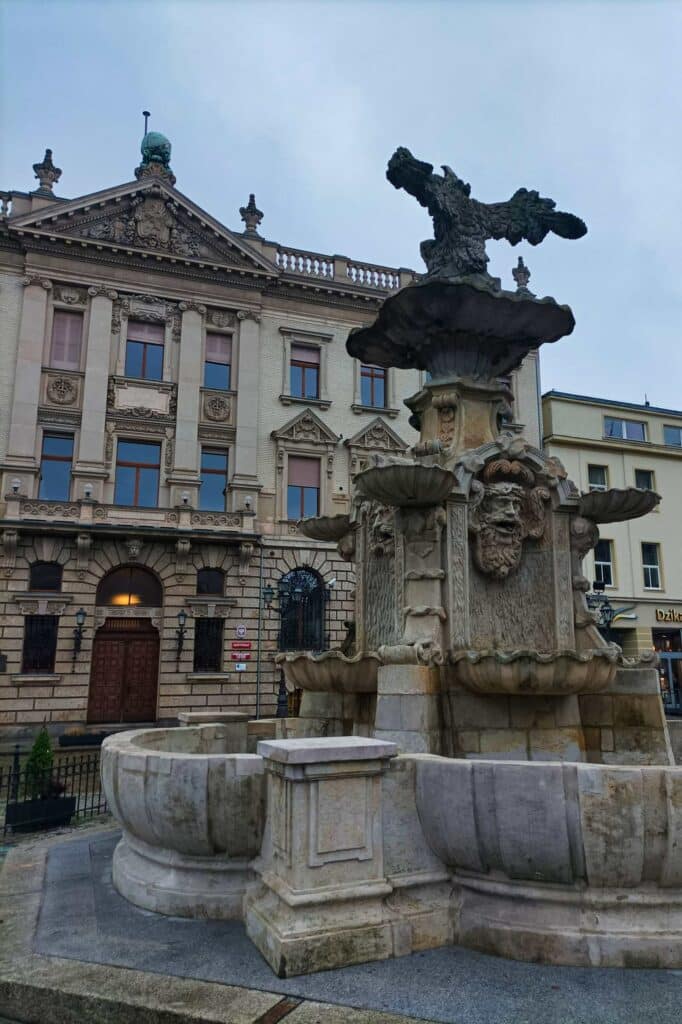
White Eagle Square/Rossmarkt
Immediately north of the cathedral is a small square dominated by the so-called Globus Palace. The magnificent neo-baroque building was erected in 1890 for the “Allgemeine Versicherungs-Aktiengesellschaft National” and today serves as the seat of the Szczecin Academy of Art. In front of the building is the magnificent White Eagle Fountain, which gave the square its name. It was created by the Berlin architect Johann Friedrich Grael in the 18th century and was the first part of the city’s modern water supply system. Many German fountains and statues were destroyed after the Second World War. However, the fountain eagle was lucky that the bald eagle also adorns the Polish national coat of arms and is therefore still allowed to spread its wings today.
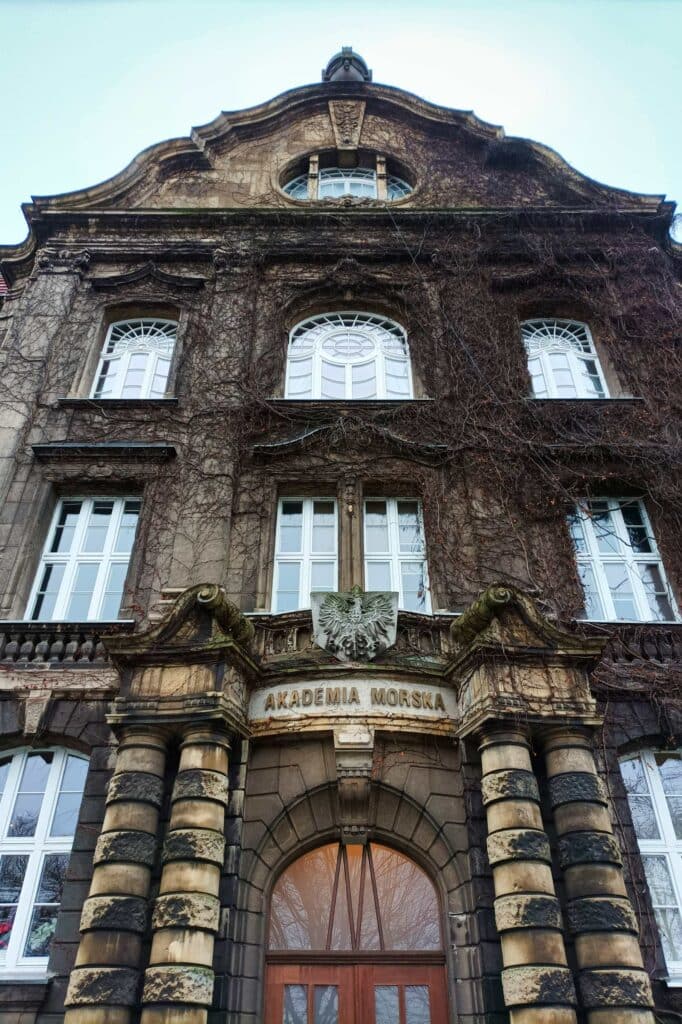
Hook terrace
The dispute over which of Szczecin’s many historical sights is the most magnificent must be settled between the Hakenterrasse and the castle. However, the elongated, 500-metre-long facility, known as Wały Chrobrego in Polish, certainly has good arguments in its favor. But if you thought that the Hakenterrasse is called that because it has a hook, you’ll be proven wrong. It was named after the former Lord Mayor Hermann Haken. The street is home to some of the most magnificent buildings from around 1900.
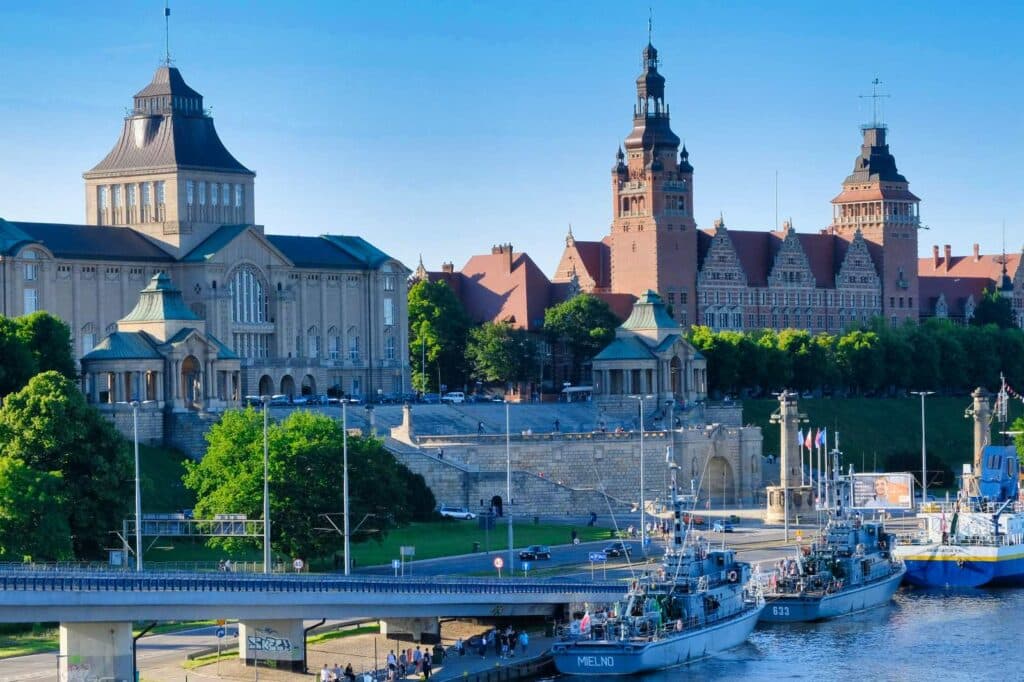
As you can see in the picture, it is actually a terrace that sits above an artificial grotto. There is a stylized lighthouse pavilion on either side of the magnificent staircase. The huge building on the right is the Voivodeship Office and thus the most important administrative building in West Pomerania. On the left, however, you can see the impressive National Museum building, which the staircase leads directly to. Right next to it is the Marine Academy, which you can see in the photo above. It offers various degree courses in the fields of seafaring, freighters and electrical engineering. From the terrace you have a great view across the Oder to the city’s modern harbor.
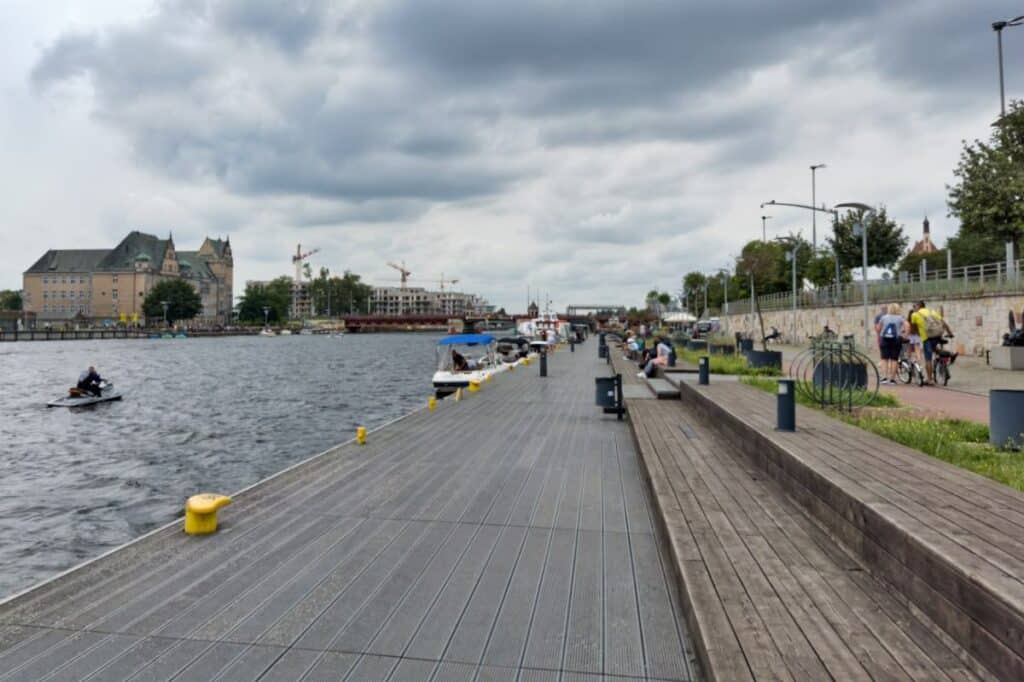
Harbor promenade
Speaking of the harbor! The entire riverside promenade along the Oder is a sight in itself. You can walk along the promenade for several kilometers on both sides of the Oder. Ships are moored in several places. These are not just inland vessels that sail on the Oder and the local canals. Ocean-going vessels can also be seen here. A particular highlight every year is the “Żagle” sailing festival, which attracts many ships from all over the world. It is the Polish equivalent of Kiel Week.
On the eastern side of the harbor opposite the old town you will also find the two islands of Łasztownia and Grodzka. There is a marina on Grodzka where you can hire motorboats without a license. Many concerts and parties take place in the beach club next door. But you can also chill out on a beach lounger in the sand and drink cocktails.
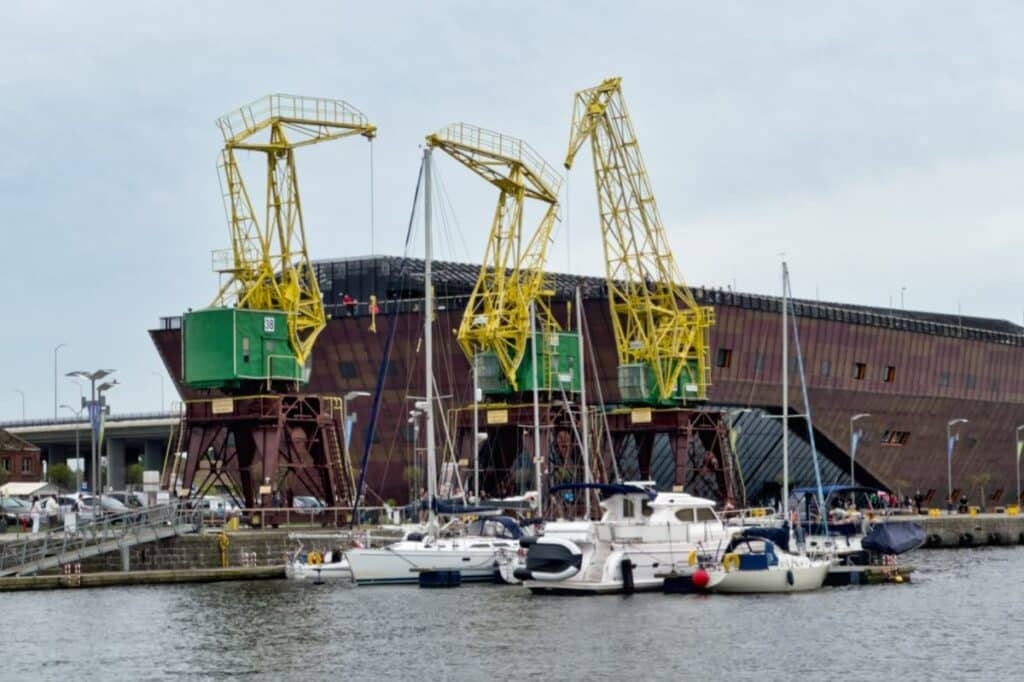
Maritime science center and cranosaurs
In Łasztownia you will find the super cool Maritime Science Center. There are interesting exhibitions on all aspects of marine science. The interactive museum is a real highlight, especially for children, as they can touch and try things out everywhere. The building is often beautifully illuminated in the evening. This looks particularly good with the cranosaurs, three decommissioned and painted freight cranes.
Wheel of Szczecin
In summer, Łasztownia also hosts the Wheel of Szczecin summer festival. The Ferris wheel Wheel of Szczecin offers a great view of the harbor and is definitely better than the glass tower of the cathedral. However, the Ferris wheel in Szczecin also costs 40 zloty, or almost 10 euros. But you can take better photos from here, the windows are pretty clean and if you like, you can hold the camera out at the top without the glass.
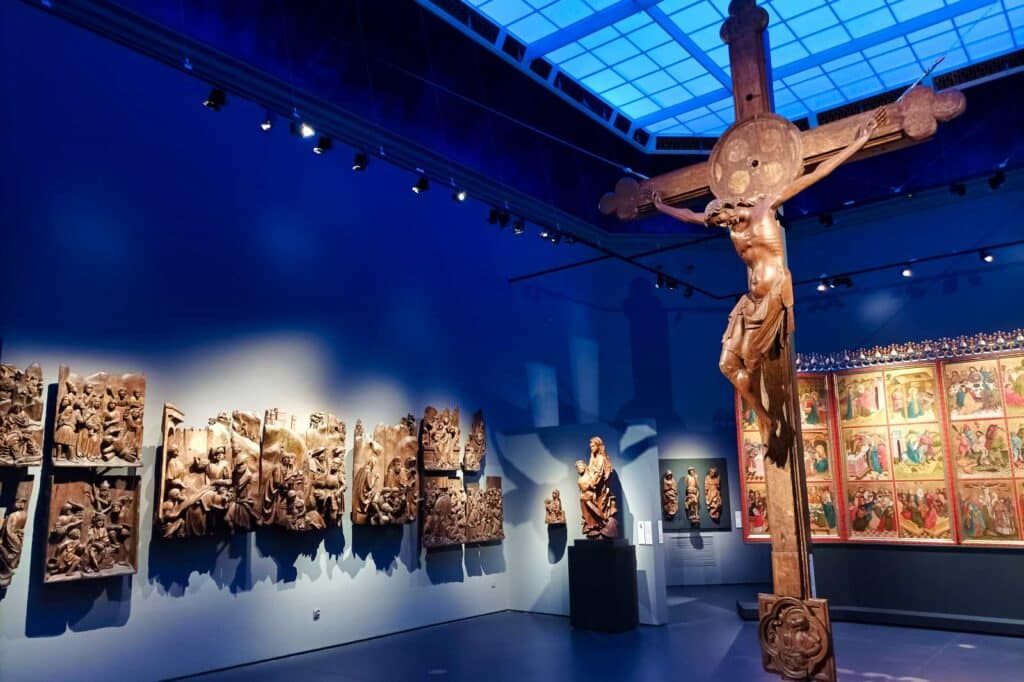
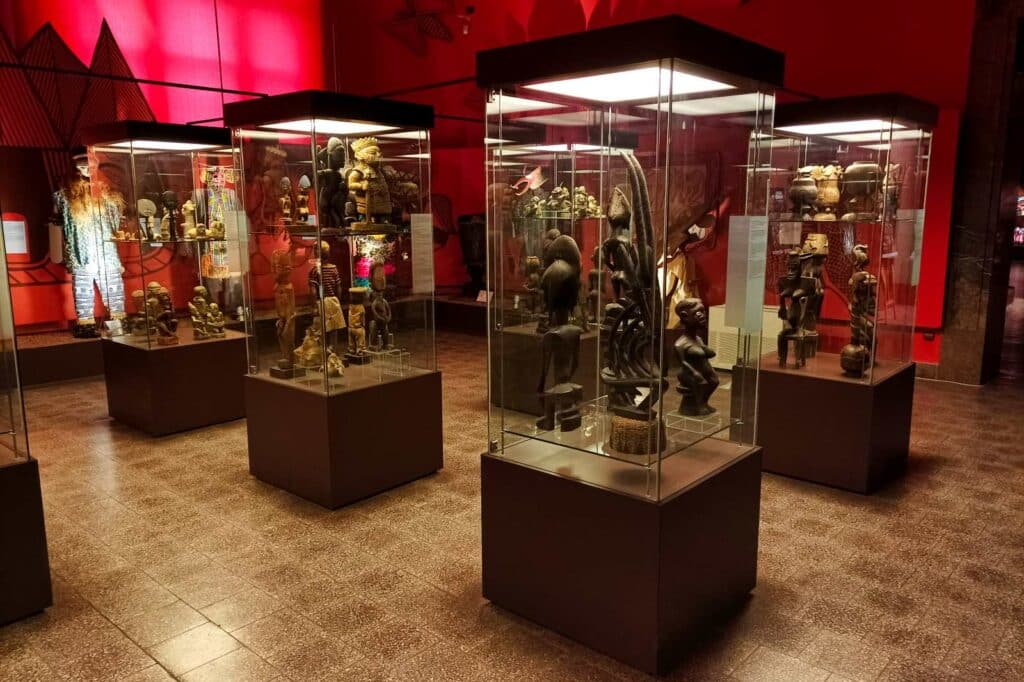
National Museum
The National Museum was founded shortly before the outbreak of the First World War as the Szczecin City Museum and has been in operation ever since. But anyone expecting a mere recounting of the city’s history here is mistaken. In fact, there is almost nothing in the National Museum that does not exist: medieval Pomeranian art, paintings from the 16th and 17th centuries, copies of ancient bronze sculptures and a huge ethnological collection, which even includes entire reconstructed African villages! It is also home to the Modern Theater, where you can see many Polish plays. However, these special performance spaces are overshadowed by another venue, the modern Philharmonic Hall, which is just a stone’s throw away from the museum.

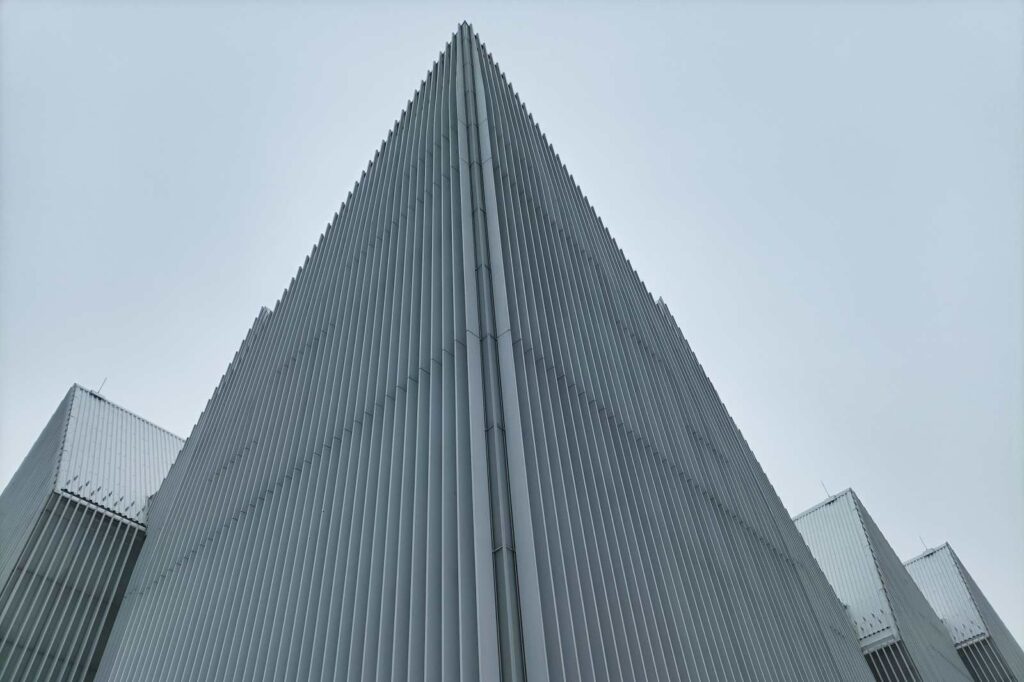
Philharmonic Hall
Hamburg has its Elbphilharmonie, Szczecin has the Mieczysław Karłowicz Philharmonic Hall. It will probably have been significantly cheaper than its German counterpart, but it is certainly no less beautiful. Inaugurated in 2014, the building designed by architects Alberto Veiga and Fabrizio Barozzi was even awarded the Mies van der Rohe Prize, the most important European architecture prize, in 2014. If there is no performance taking place, you can visit the impressive foyer with its curved staircase and have a snack in the museum café. The performances are really worthwhile and are also very reasonably priced. You can also find tickets in German on the Philharmonie’s website. There are also guided tours in German or English once a month on a Friday.

Dialog Center “Upheavals”
What might be behind the strange name Umbrüche? When we visited Szczecin, we didn’t know exactly what to expect. A spectacular entrance next to the Philharmonic Hall leads underground and displays a dark, fascinating and varied exhibition on life after the upheaval that the end of the Second World War marked for Szczecin. Particular emphasis is placed on the importance of Szczecin in the context of the workers’ unrest and the emergence of the Solidaność movement. Cool feature of the subsection of the National Museum: you can take a 3D tour here if the exhibition is currently closed. Simply click on the play button and then on “Wejdź do środka”. Incidentally, the small bistro in the foyer of the center offers sandwiches with paprykarz – the delicacy from Szczecin (more on this later).
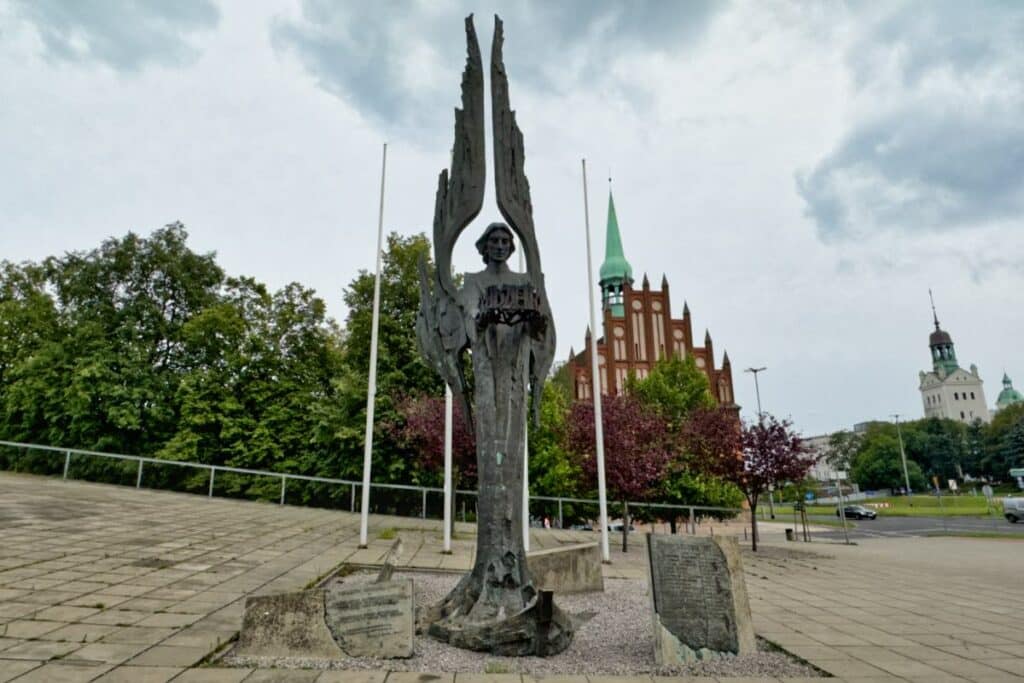
Monument to the insurgents
Solidaność Square (plac Solidarności) is located above the museum. Here stands an impressive bronze angel weighing almost 10 tons, holding a stylized inscription with the word “December” (Polish: grudzień), which with a little imagination can also be interpreted as a crown of thorns, a symbol of the historical suffering of the Poles. The angel commemorates the workers’ strike, which claimed numerous victims and was bloodily crushed by the communist rulers. The memorial was inaugurated in 2005, just in time for the 25th anniversary of the August Agreement. These are several contracts concluded between the communists and opposition leaders. The Szczecin Treaty was the first of these and thus the first in the entire Eastern Bloc at the time in which an opposition movement was recognized by the state.
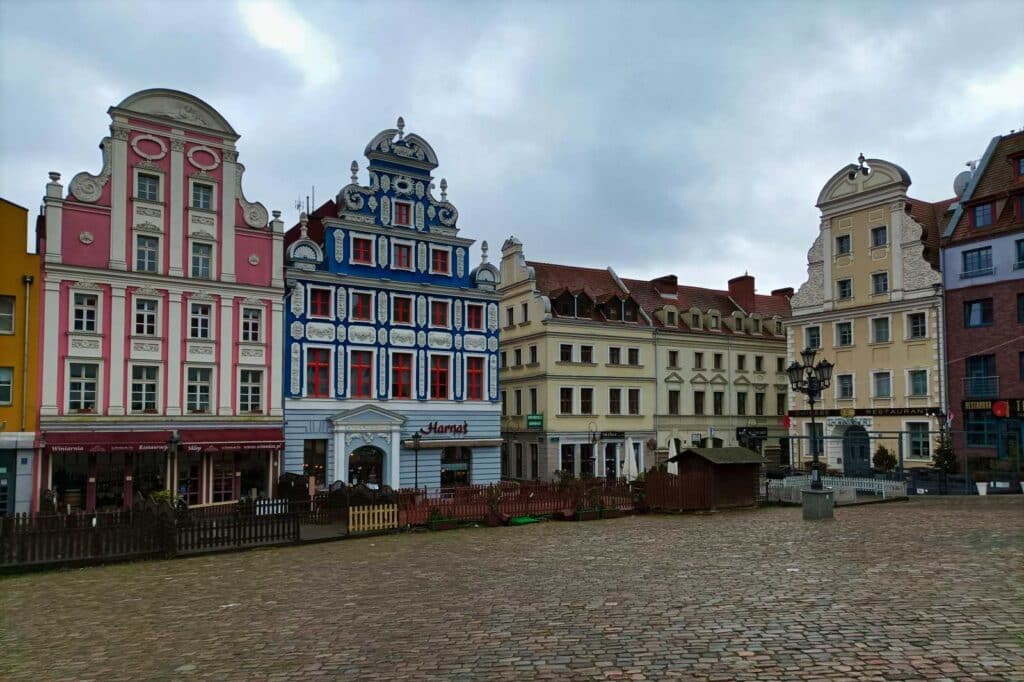
Haymarket
Today’s Rynek Sienny is a good example of how historical buildings were treated in Poland after the Second World War and why Polish restorers enjoy an excellent reputation worldwide. Just like large parts of the rest of the old town, the Heumarkt had been almost completely destroyed by bombing. Here you can feel what life must have been like in the city before the war like nowhere else. In summer, Heumarkt is also a popular meeting place, as there is a café or restaurant in almost every building on the square. The Old Town Hall (also rebuilt) is a particular eye-catcher. The impressive brick building houses, among other things, the Wyszak brewery restaurant in its beautiful vaulted ceiling (see below).

Loitzenhaus (Kamienica Loitzów)
The Loitzenhaus is a listed late Gothic building and was built in the 1540s. The building is closely associated with the Loitz merchant family. The collapse of the family’s empire after the Polish rulers failed to repay loans granted to them, the family fled to Krakow. This had long-lasting effects on the economy of Szczecin. Badly damaged in the Second World War, it now houses the city’s art college. Particularly noteworthy on the Loitzenhaus is the relief depicting the conversion of Saul.
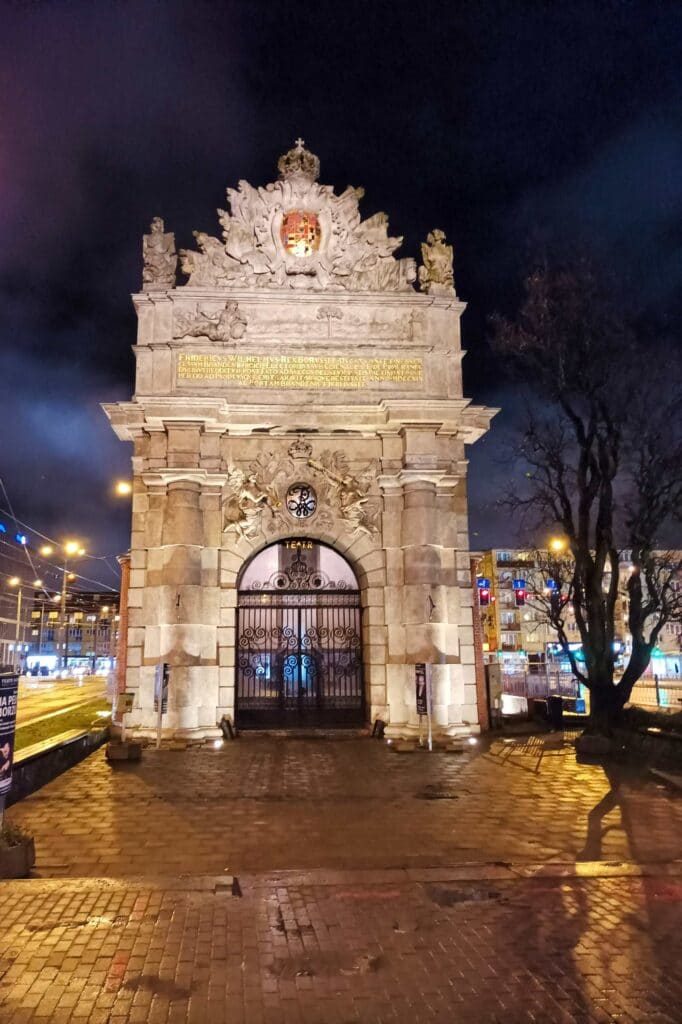
Berlin Gate
Today, the Berlin Gate is usually referred to as the Port Gate (Polish: Brama Portowa) and is special in several respects. On the one hand, it is the old city gate that marked the entrance to the fortress of Szczecin. On the other hand, it somehow seems to be the only place in the area that has not kept up with the times, as traffic roars around the gate and there are numerous modern post-war buildings.
The magnificent baroque façade is a reminder that Szczecin, like other parts of Western Pomerania, was acquired by Prussia in 1720. This creates an interesting contrast, especially with the surrounding buildings. Today, the gate houses a small theater. There is a second historic city gate in Szczecin, the Königstor (King’s Gate), which is located further north, also on a crossroads.
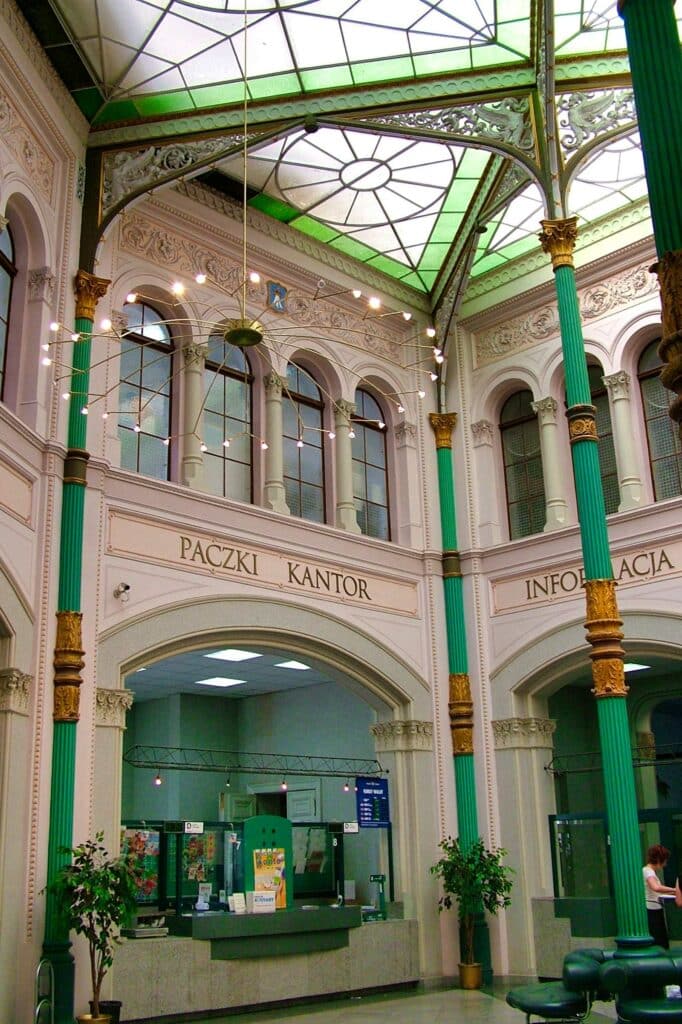
Main post office
Post office buildings are not normally among the places we present to you in our blog. But we are happy to make an exception here, because the huge brick building not far from the main railway station is one of the most beautiful post offices in the country. On the outside, it resembles a kind of castle, while the interior of the neo-renaissance building is delicate and the light-flooded hall with its glass roof is a real eye-catcher. If you have come by train, you can not only change money here at better rates than at the main station, but also buy some of the beautiful Polish stamps as souvenirs.

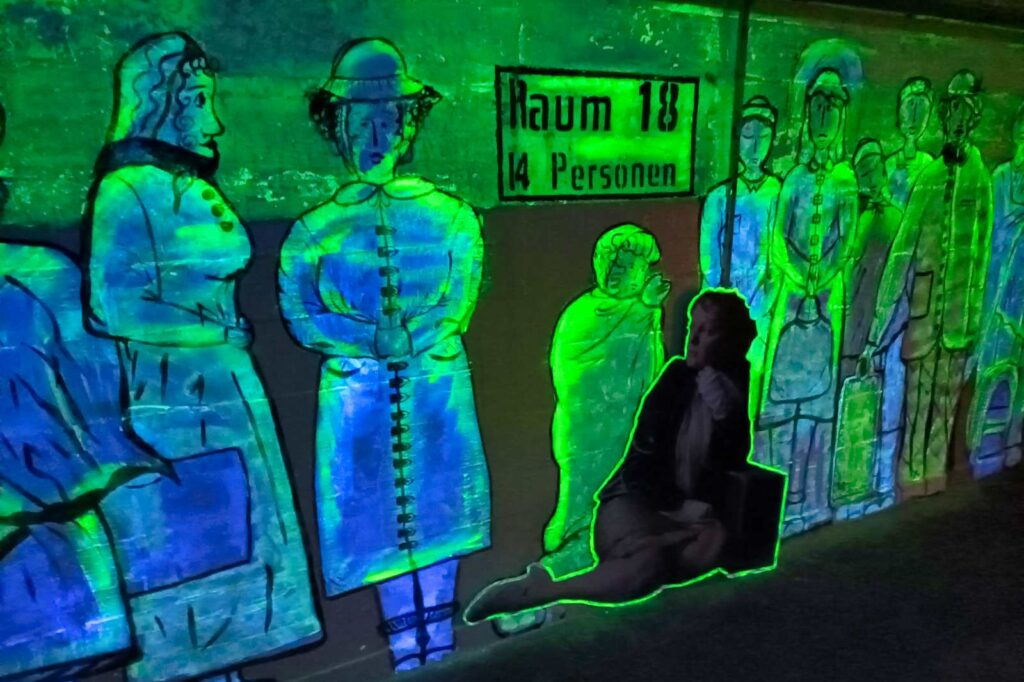
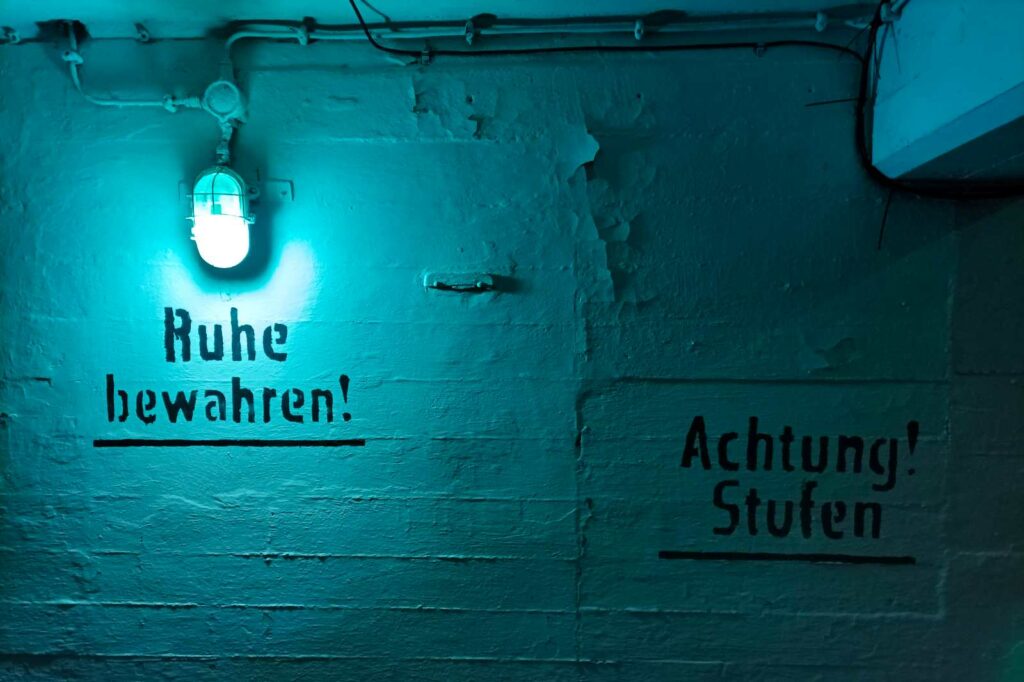
Bunker under the main station
Hardly any of Szczecin’s sights impressed us as much as the Underground City Trails. To find them, you first have to search a little, as the entrance is not in a building, but directly on platform 1 of the main train station. From here, you can embark on an exciting journey of discovery into Szczecin’s underworlds. The underground facility is the largest civilian air raid shelter in Szczecin. It was built by the Nazis and was one of the reasons why comparatively few residents lost their lives in bombing raids during the Second World War, as it could hold thousands of people.
You can also find out about the exciting history of the plant here in German. After the war, it continued to be used as an air raid shelter, which is why it also provides information about the Cold War, the period of socialism in Poland and everyday life at the time. The varied visit is rounded off by art installations that correspond well with the rooms.
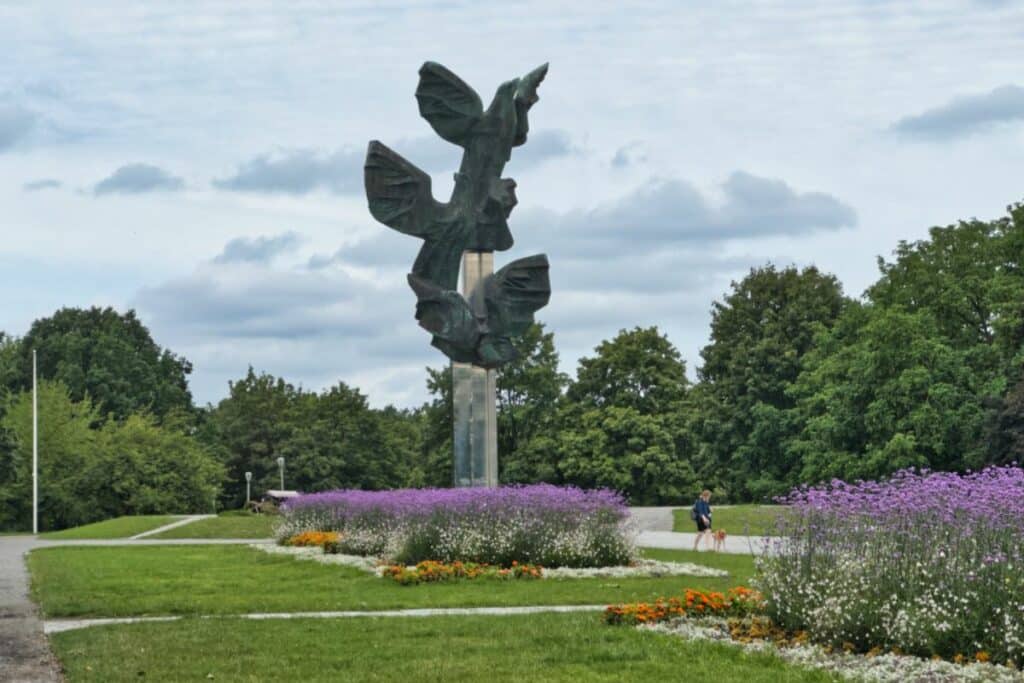
Jasne Błonia
Jasne Błonia is an impressive square in the heart of Szczecin, located directly behind the city administration building. With its extensive green spaces and old trees, it is a popular place for locals and tourists to relax and admire the fountains and flowerbeds. But the highlight of the park is undoubtedly the monument to the Polish deed. This monumental memorial was unveiled in 1979 on the 40th anniversary of the Nazi invasion of Poland. The sculpture, which consists of three soaring eagles, symbolizes the tireless spirit and sacrifice of the Polish people. The eagles stand for the Poles who have shaped Poland, for those who are shaping it now and for those who will shape it in the future.
On the spacious square at the entrance to Kasprowicza Park, another monument also commemorates the Polish Pope John Paul II, who appeared here twice.

Central cemetery
There are also some really beautiful Szczecin sights outside the city center. With an area of almost 179 hectares, the Central Cemetery (Polish: Cmentarz Centralny) is today the third largest cemetery in Europe and yet it is virtually unknown in Germany! The area was laid out around 1900 and more than 300,000 people have been buried here. From the outset, the plan was to use it as a place to stroll, which is why there are a large number of different trees from different regions of the world – over 500 different species. The monument to the brotherhood of arms that you can see above is particularly impressive. It was unveiled during the communist era and stands in the center of the military part of the tomb.
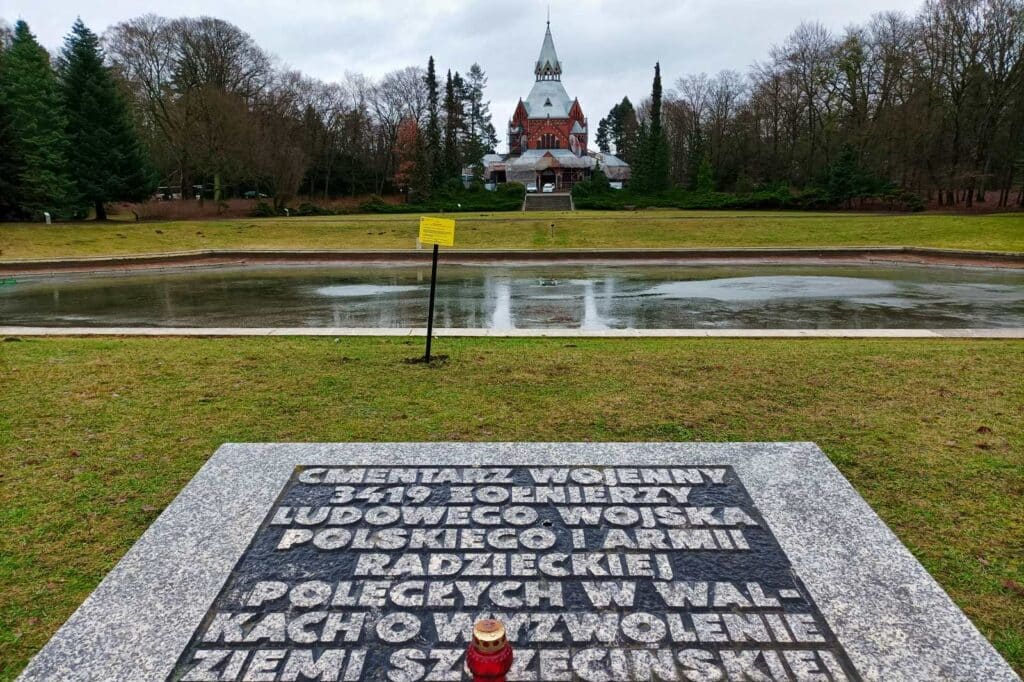
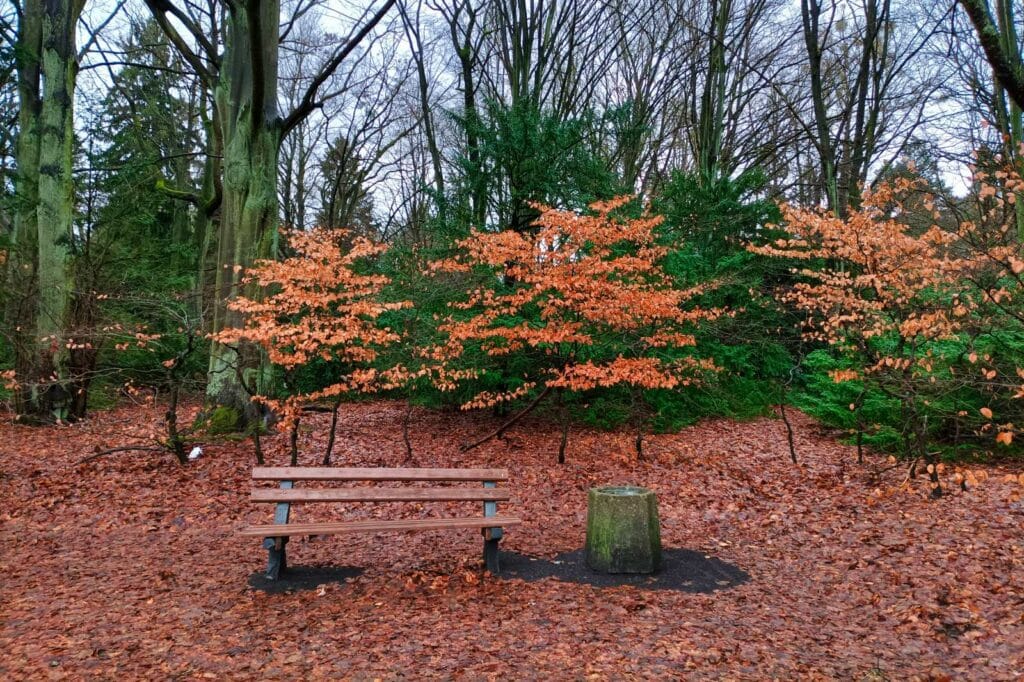
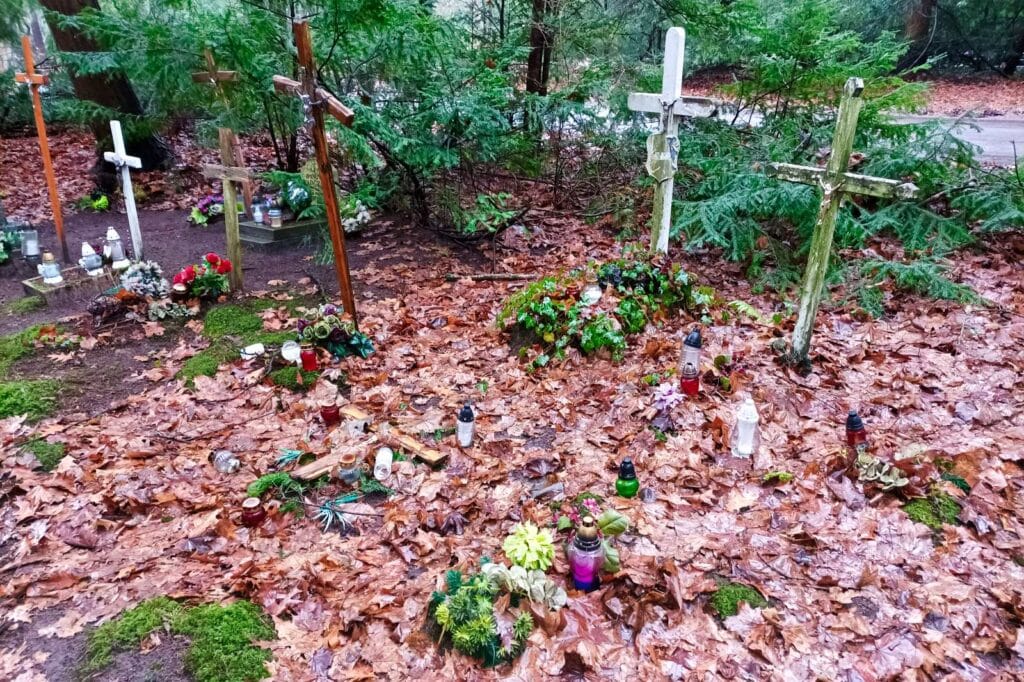
But there are also many other exciting places to discover, with surprising perspectives literally around every corner. You should therefore definitely allow more than two hours for your visit to explore the fountains, memorials, graves, chapels and tree species, which are conveniently explained on information boards.
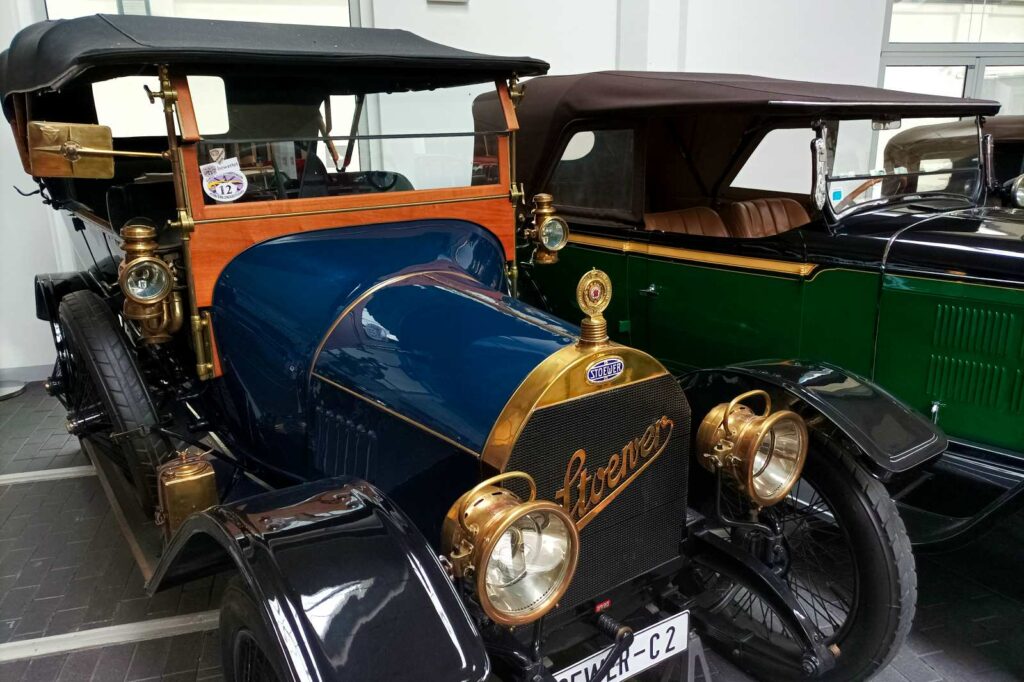
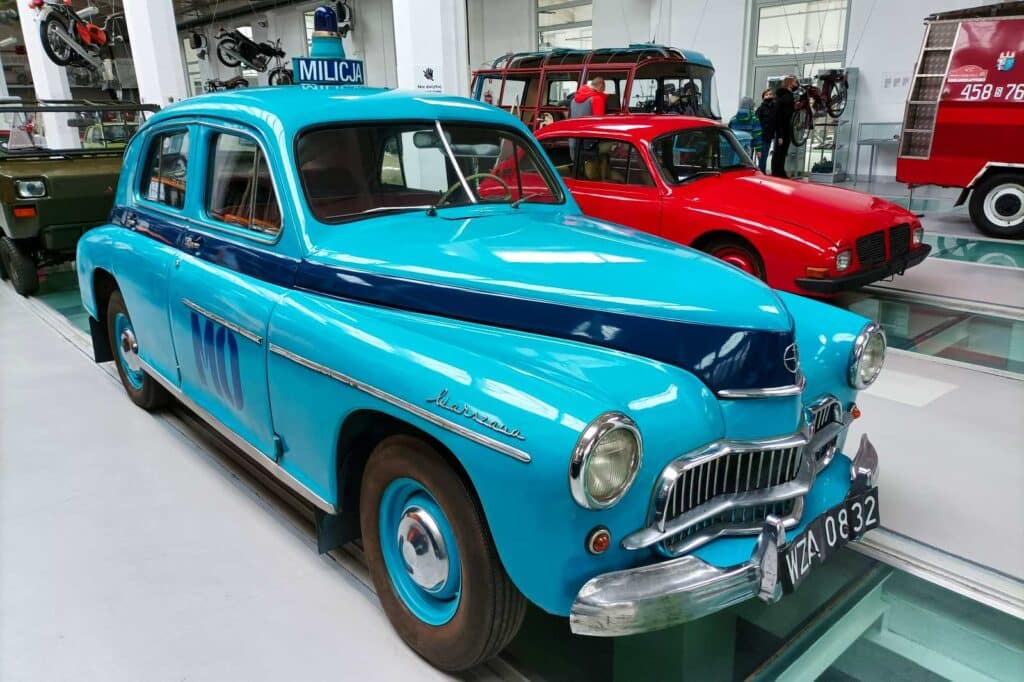
Museum of Technology and Communication
In the north of the city, you will find an exciting museum for technology fans in an old streetcar depot. Here you can see, among other things, numerous exhibits from the field of communication (the term is very broad), but above all many cars in excellent condition. The most important of these come from the Stoewer factory. The company existed in Szczecin between 1858 and 1945 and produced numerous luxury cars, among other things. The many exhibits you can admire here make up the largest Stoewer collection in the world! The cars are the new star in the Szczecin exhibition sky, as they were on display in Wald-Michelbach in Hesse until 2019.
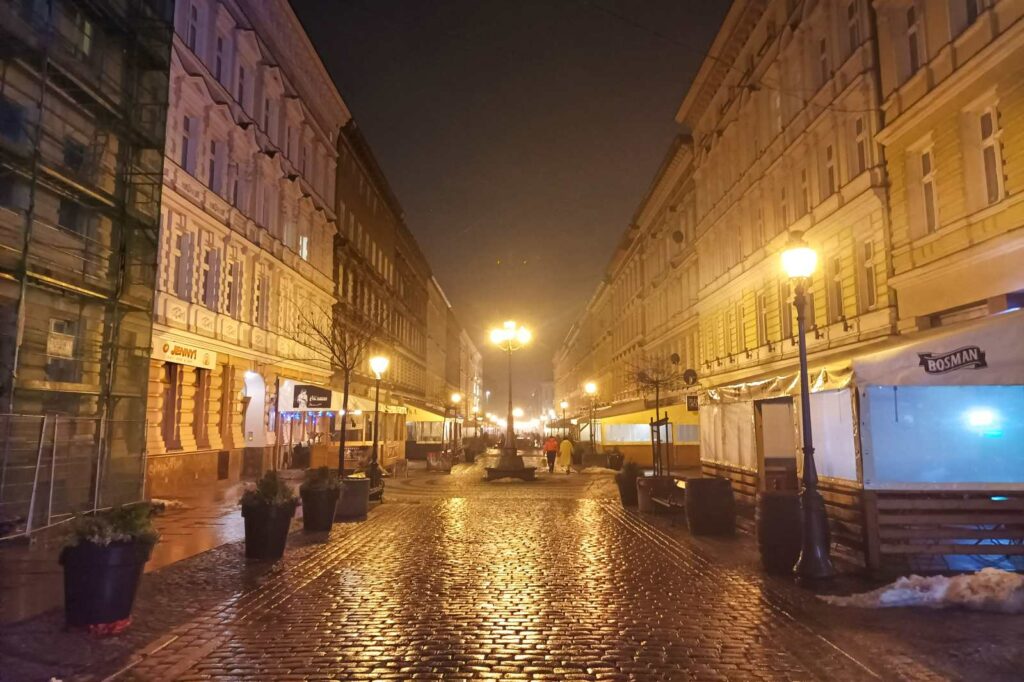
Tips for eating and drinking in Szczecin
After all the sightseeing in Szczecin, you’re bound to be hungry. At any time of day or night, ulica Księcia Bogusława X should be a tip. There is always a restaurant or bar open for you here. But we’ve put together a few more tips for you!
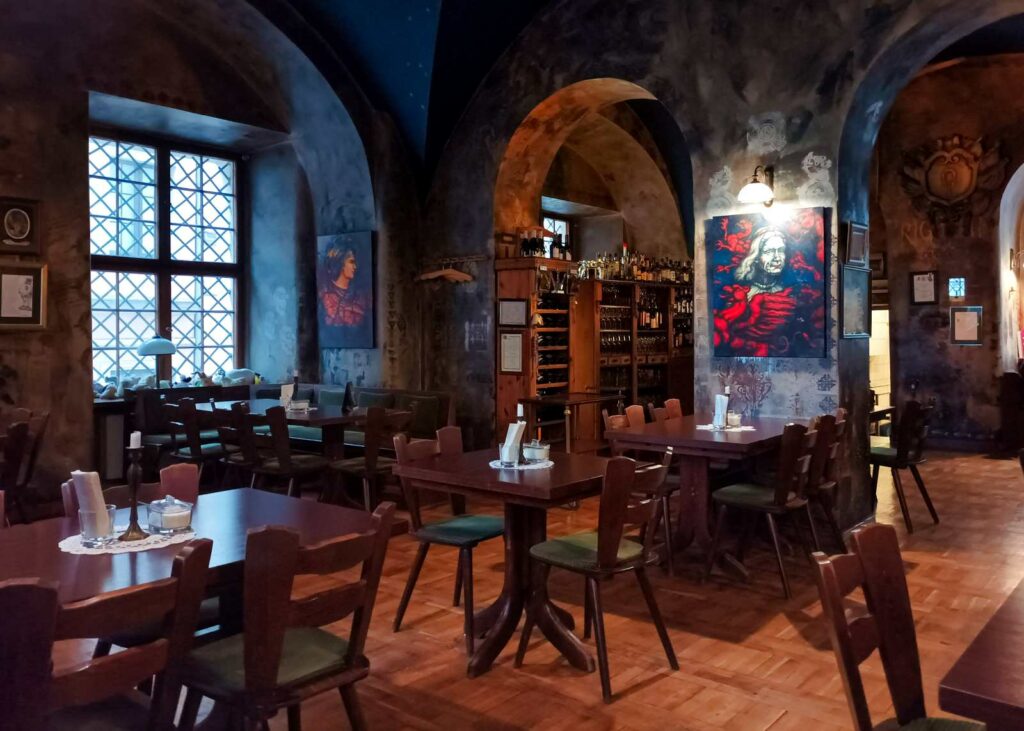
- Na Kuncu Korytarza, in the castle of the Pomeranian Dukes. One of the best restaurants in the city is located in the beautiful rooms of the castle. From Thursday to Saturday, you can enjoy not only the finest Polish jazz, but above all delicious Polish cuisine. Herring dishes are the specialty of the house – after all, the people of Szczecin are not called paprikarzy for nothing, as mentioned at the beginning.
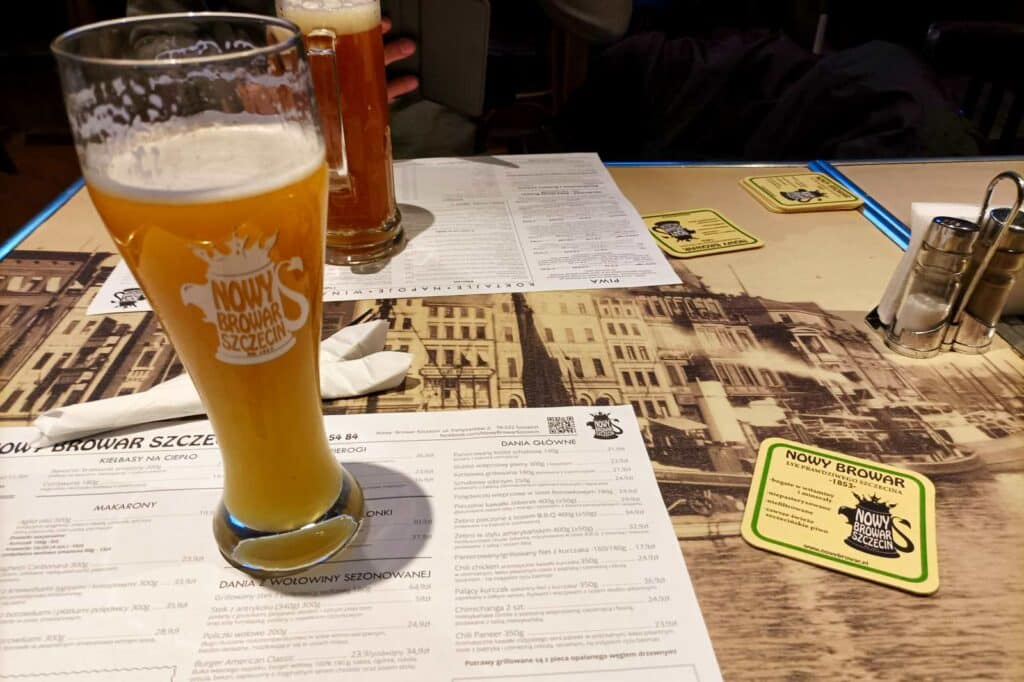
- Nowy Browar, ul. Partyzantów 2. The “New Brewery” is known far beyond the city limits and we have already discovered its products in other parts of Poland. It serves good Polish home cooking and pizzas, but above all several beers on tap, of which we found the wheat beer particularly excellent.
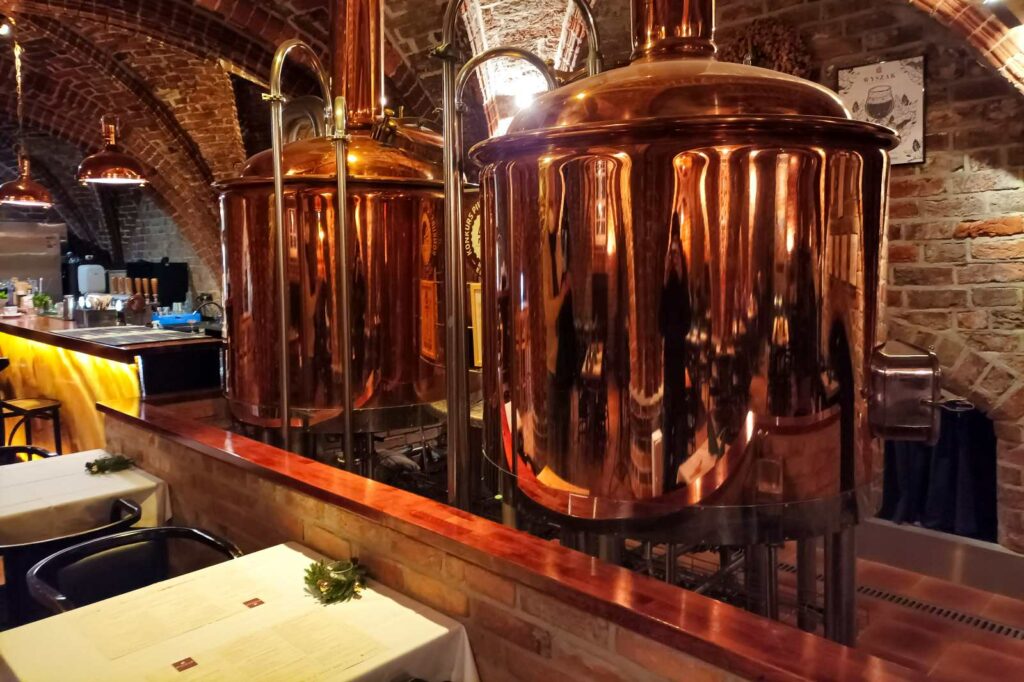
- Wyszak, ul. Księcia Mściwoja II 8 The Wyszak brewery, which is housed in the vaults of the Old Town Hall on Heumarkt, is just as beautiful as Na Kuncu Korytarza. It serves a variety of beers (including a tasting set) and award-winning Polish cuisine of a high standard. And if you want to think of your loved ones at home, why not bring them a beer gift set from here?
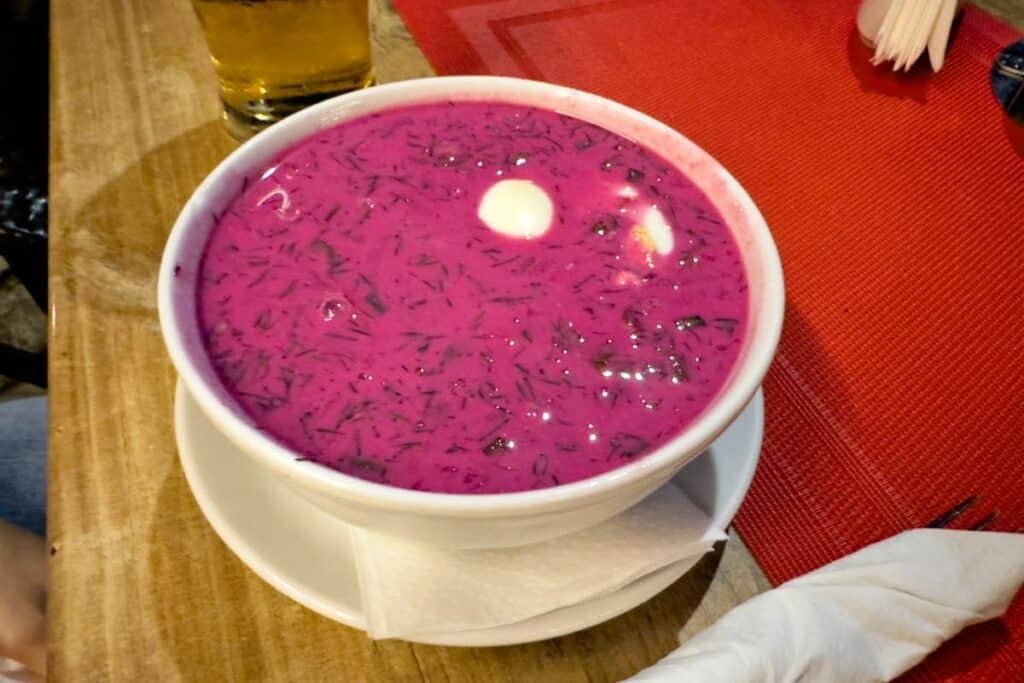
- Karczma Polska Pod Kogutemfurnished in the style of a Polish farmhouse, this place serves really great Polish cuisine. Everything we ate here was excellent. We particularly recommend the Lithuanian-style cold borscht, the pierogi and the black pudding. Smacznego!
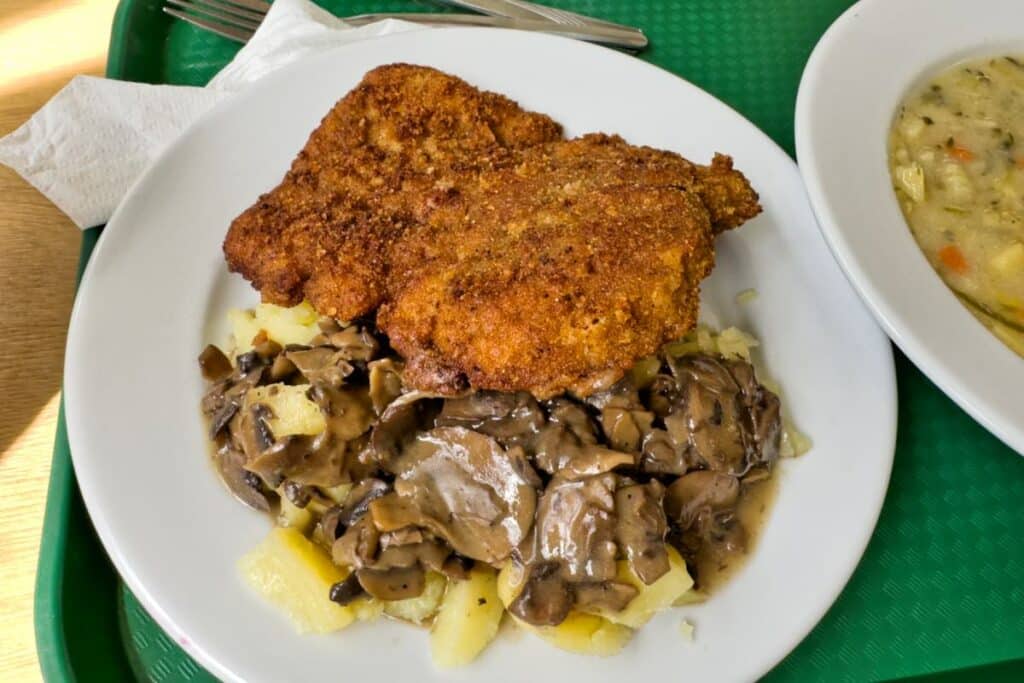
- Bar Mleczny TurystaEdmunda Bałuki 6A. What would a visit to Poland be without a meal in a milk bar? A visit to these canteens of the people is always an experience. The whole of Poland eats here. In Szczecin, we particularly liked the Turysta milk bar. The food was plentiful and delicious, and the prices were reasonable. The queue was short for us, but only a little later it was much longer.
City tours through Szczecin
A guided tour in Szczecin allows you to explore some of the city’s hidden treasures, learn more about life in the city and in Poland and also hear the stories behind the historic buildings. A food tour will also introduce you to the authentic flavors of Polish cuisine. Here we have a small selection of tours that you can book through our partner GetYourGuide.
-
Szczecin: Old Town Highlights – Private Tour*
Fall in love with the history and culture of Szczecin’s Old Town on this private tour. You will visit highlights such as the Church of St. Wojciech, the Cathedral, the Philharmonic Hall and the Hook Terrace. The tour offers you the opportunity to experience the city’s rich history and impressive architecture up close. -
Szczecin: Craft beer tour*
This craft beer tour in Szczecin is a great way to quickly get to know the best beer pubs in Szczecin. Discover the local beer culture and taste different Polish beers in selected pubs and breweries. Experienced guides will tell you interesting facts about beer production and traditions in Poland. The tour also offers the opportunity to try local snacks that go perfectly with the beers. -
Szczecin Underground and Old Town Private City Tour*
Immerse yourself in the mysterious world of Szczecin’s underground and explore the Old Town on this private guided tour. The tour will take you through the underground bunkers and tunnels built during the Second World War. Your guide will tell you fascinating stories about the history of the city and how these underground structures were used. Afterwards, you will explore the Old Town and learn more about the architecture and culture of Szczecin.
These three tours offer a diverse mix of history, culture and enjoyment that will enrich your stay in Szczecin.
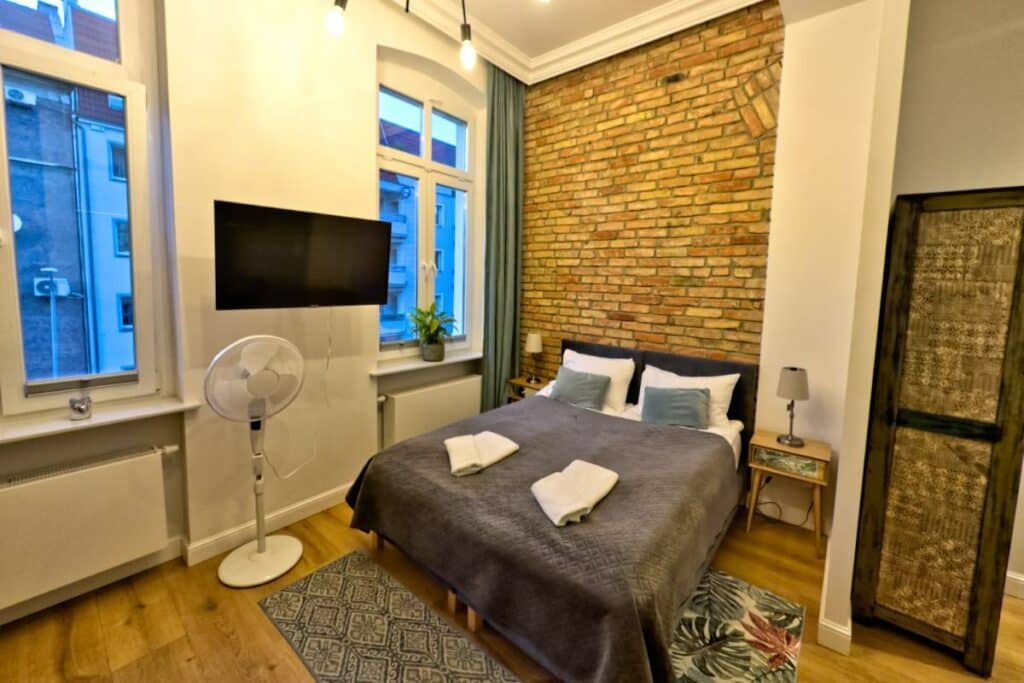
Tips for staying overnight in Szczecin
Szczecin has a plethora of great hotels and accommodation. To make your search a little easier, we have listed a few recommendations here.
-
Radisson Blu Szczecin*
The Radisson Blu Szczecin is a modern hotel with elegant rooms and suites, restaurants, a spa and free breakfast. It is located in the heart of the city, close to all major attractions. The Radisson probably has the most comfortable beds in the city. The hotel is not cheap but you get what you pay for. -
Moxy Szczecin City*
Moxy Szczecin City is a relaxed hotel with stylish rooms, a trendy bar and good free Wi-Fi. It is located right next to Brama Portowa, close to bars, restaurants and stores. The hotel is super modern, but always offers reasonable prices. The staff is friendly and the hotel has a lively atmosphere. Great breakfast! -
Kamienica 1899*
The small, cozy aparthotel Kamienica 1899 is located directly in the Wilhelminian style district around plac Grundwaldski. The rooms are modern, offer every comfort, but exude the charm of the Wilhelminian era. There is no breakfast, but there are excellent restaurants in the area and in the evening you can also walk to all the cool bars in less than ten minutes. We had a great stay here. -
Studencki Dom Marynarza Pasat*
The Marynarza Pazat student house offers simple rooms for a small price. The rooms are clean and well-kept, and there is a private bathroom. There is no breakfast, but there are plenty of restaurants nearby.
Clever savings with the Szczecin Tourist Card
Last but not least, we would like to give you a tip on how you can explore the many beautiful sights of Szczecin conveniently and cheaply. Simply buy the Szczecin Tourist Card. It is available for either 24 or 72 hours and costs just 20 or 30 złoty, i.e. less than four or six euros respectively. You can use public transport for free, get a 50% discount at all museums and discounts at numerous other attractions, hotels and restaurants. Definitely an unbeatable offer for the low price!
The best place to buy it is at the tourist information office in Szczecin. You can also buy the card in the GoPay app. Unfortunately, the developers didn’t take into account that tourists in particular don’t have a Polish telephone number. I couldn’t even register with a German number.
We hope you enjoyed our little trip to West Pomerania to see the many sights of Szczecin. Leave a comment and let us know how you like the city.
Szczecin book recommendations
There are also several books about beautiful Szczecin and its sights. Here is a selection for you.
- Kuna, Dr. Edwin (Author)
- Kissling, Ute (Author)
This article was created thanks to the generous support of the Polish Tourist Office Berlin.


